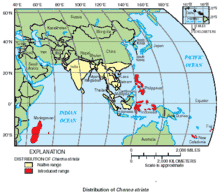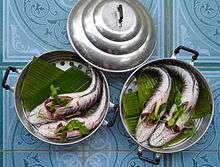Channa striata
| Striped snakehead | |
|---|---|
 | |
| Channa striata, after Bleeker, 1879 | |
 | |
| Scientific classification | |
| Kingdom: | Animalia |
| Phylum: | Chordata |
| Class: | Actinopterygii |
| Order: | Perciformes |
| Family: | Channidae |
| Genus: | Channa |
| Species: | C. striata |
| Binomial name | |
| Channa striata (Bloch, 1793) | |
 | |
| Distribution of Channa striata.[2] Madagascar reports are misidentifications of C. maculata[3][4] | |
| Synonyms[2] | |
| |
Channa striata, the striped snakehead, is a species of snakehead fish. It is also known as the common snakehead, chevron snakehead and snakehead murrel. It is native to South and Southeast Asia, and has been introduced to some Pacific Islands (reports from Madagascar and Hawaii are misidentifications of C. maculata).[3][4]
Introduction
It grows up to a meter in length, though because of fishing, this size is rarely found in the wild. It has a widespread range covering southern China, Pakistan, most of India, southern Nepal, Bangladesh, Sri Lanka, and most of Southeast Asia. It has more recently been introduced to the outermost parts of Indonesia, the Philippines, and Mauritius. Reports beginning in the early 20th century that it was introduced into the wild in Hawaii, particularly the island of Oahu, as well as later reports from Madagascar, are the result of misidentifications of C. maculata.[3][4] The only currently confirmed Hawaiian establishment of C. striata is on a commercial fish farm. Popular media and the United States Fish and Wildlife Service were perpetuating this apparent mistake as recently as 2002.[5][6] Early- to mid-20th century reports and texts referring to its introduction in California appear to be the result of a misunderstanding.[7]
It is an important food fish in its entire native range, and is of considerable economic importance. Adults are dark brown in colour with faint black bands visible across its entire body. Males and females both help to construct a nest out of water vegetation during breeding time. Eggs are guarded by both parents. Fry are reddish orange and are guarded by both parents until they turn greenish brown at around 5–6 cm.
It is common in freshwater plains, where it migrates from rivers and lakes into flooded fields, returning to the permanent water bodies in the dry season, where it survives by burrowing in the mud.
It preys on frogs, water bugs, and smaller fish, and it will attack anything moving when breeding.
Nomenclature
Common snakeheads are known as Nga-mu in Meitei, xol in Assamese, shol (শোল) in Bengali,Sheula (ଶେଉଳ) in Odia, varaal (വരാല്)) in Kerala, India; viral/mural/selumural/nedumural (in Tamil: விரால்,முறால்,செலுமுரல்,நெடுமுரல்) in Tamil Nadu, India; Koramenu/Korra matta(Telugu: కొర్ర మేను/కొర్ర మట్ట), India; and Loola ලූලා in Sri Lanka; pla chon (Thai: ปลาช่อน) in Thailand;[8] gabus in Indonesia; haruan in Malaysia;[9] and haloan, aruan, haruan, halwan, bulig, dalag, or "mudfish" in the Philippines.
Gastronomy

A curry made with this fish and tapioca is a delicacy in Kerala. In Indonesia, common snakeheads are a popular type of salted fishes in Indonesian cuisine. In the Philippines, they are commonly served either fried, grilled, or with soup.
Dishes using this fish eaten with rice is very popular among Bengalis of Bangladesh and West Bengal.
Common snakeheads are very popular in Thai cuisine, where they are prepared in a variety of ways. Grilled fish is a common food item offered by street vendors or in kaeng som. Pla ra, a fermented fish sauce popular in northeastern Thai cuisine, is made by pickling common snakehead and keeping it for some time. Also, a Chinese sausage is prepared with common snakehead flesh in Thailand.[10]
Immune system
Worldwide inland fish culture industry is suffering from massive economic losses due to epizootic ulcerative syndrome (EUS) and fish based pathogens. The available literature indicate that infection from fish pathogens like bacteria (Aeromonas hydrophila and Aeromonas sobria), fungus (Aphanomyces invadans) and viruses can cause stunted growth and severe mortality in the C. striatus. Channa striatus rely on their innate immune components to fight against these infections. Some of the immune molecules that have been characterized in Channa striatus includes Chemokine, Chemokine receptors, Thioredoxin, Superoxide dismutase, Serine Protease, Cathepsin,[11] Lectin.
In culture
The Bathini Goud Brothers in Hyderabad, India, promote the swallowing of live murrel fish and herbs as an asthma treatment, although the high court ruled they cannot call it "medicine". They give it free to children on Mrigasira Nakshatra. No evidence indicates it is clinically effective, and children's rights campaigners have called for it to be banned.[12][13]
Folklore among Chinese in South China and Southeast Asia has it that eating haruan fish helps in postsurgical wound healing.[14]
References

- "Channa striata". Integrated Taxonomic Information System. Retrieved 18 April 2006.
- Froese, Rainer and Pauly, Daniel, eds. (2006). "Channa striata" in FishBase. January 2006 version.
- ↑ Chaudhry, S. (2010). "Channa striata". IUCN Red List of Threatened Species. Version 2010.2. International Union for Conservation of Nature. Retrieved 8 July 2013.
- 1 2 Courtenay, Jr., Walter R. and James D. Williams. Channa striata Archived September 6, 2007, at the Wayback Machine. USGS Circular 1251: Snakeheads (Pisces, Chinnidae) - A Biological Synopsis and Risk Assessment. U.S. Department of the Interior, U.S. Geological Survey. 2004-04-01. Retrieved 2007-07-15.
- 1 2 3 USGS, Southeast Ecological Science Center: Channa striata. Retrieved 27 June 2014.
- 1 2 3 Walter R. Courtenay, Jr., James D. Williams, Ralf Britz, Mike N. Yamamoto, and Paul V. Loiselle. Bishop Occasional Papers, 2004. Identity of Introduced Snakeheads (Pisces, Channidae) in Hawaii and Madagascar, with Comments on Ecological Concerns.
- ↑ Akana-Gooch, Keiko Kiele. Hawaii snakehead lacks ferocity of mainland kin: A kinder, gentler fish, it poses no local threat to the environment. Honolulu Star-Bulletin. 2002-07-28. Retrieved 2007-07-15.
- ↑ Federal Register: July 26, 2002 (Volume 67, Number 144) Archived February 9, 2008, at the Wayback Machine.. Federal Register Online. 2002-07-26. Retrieved 2007-07-15.
- ↑ Dill, William A., and Almo J. Cordone. Chevron snakehead, Channa striata (Bloch) History and status of introduced fishes in California, 1871-1996. Retrieved 2007-07-15.
- ↑ Fishing in Thailand Archived 2009-06-29 at the Wayback Machine. (in Thai)
- ↑ Chua, Eddie. "The lure of the haruan". The Star Online. Archived from the original on 13 April 2013. Retrieved 15 March 2013.
- ↑ Recipes
- ↑ Venkatesh K, Prasanth B, Rajesh P, Annie JG, Mukesh P, Jesu A (2014). "A murrel cysteine protease, cathepsin L: bioinformatics characterization, gene expression and proteolytic activity". Biologia. 39: 395–406. doi:10.2478/s11756-013-0326-8.
- ↑ "Indians flock for asthma 'cure'". BBC News. 9 June 2003. Retrieved 5 June 2011.
- ↑ "SHRC moved against `fish medicine'". Times of India. 1 June 2011. Retrieved 5 June 2011.
- ↑ http://web.usm.my/mjps/MJPS%203(2)%202005/MJPS%203.2.3.pdf%5B%5D
External links
| Wikispecies has information related to: Channa striata |
-
 Media related to Channa striata at Wikimedia Commons
Media related to Channa striata at Wikimedia Commons - snakeheads.org
